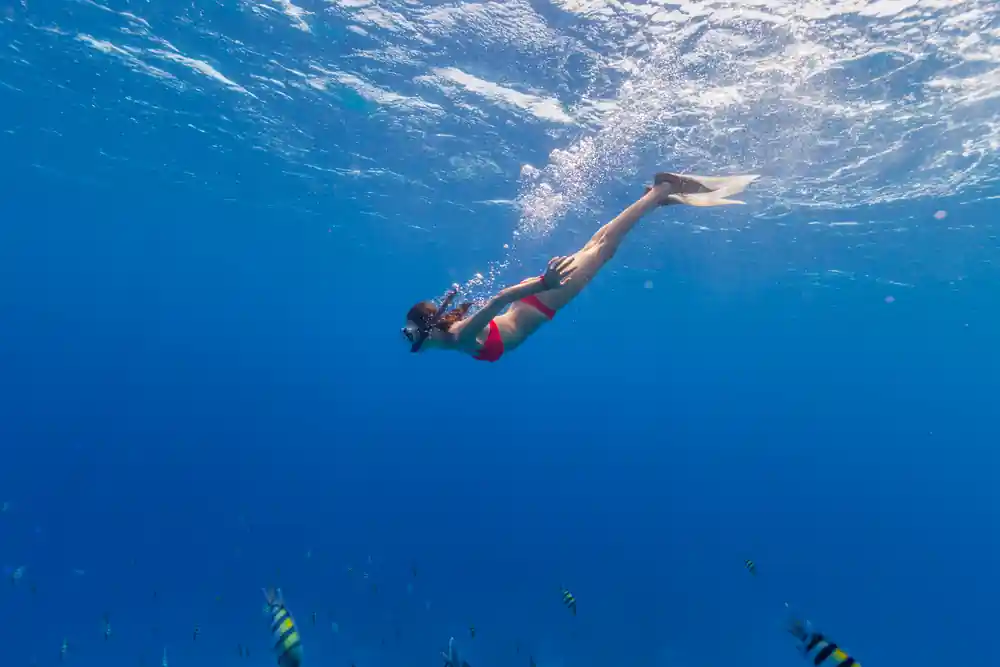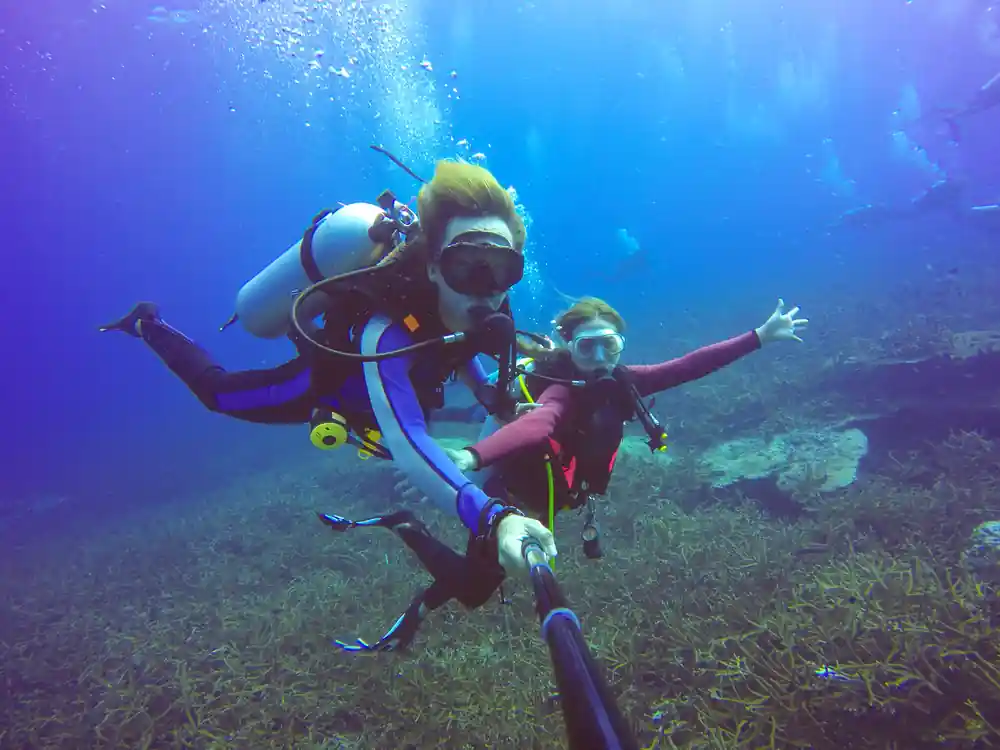There are many ways to dive, including snorkeling, skin diving, free diving, and Scuba diving. Let’s learn more about the difference between them.
Snorkeling
Snorkeling is more popular than any of the diving activities we mentioned and the one you can enjoy with the least experience. The defining point is the tendency to stay at the surface, observing the aquatic environment below. To enjoy snorkeling, you must have a mask, snorkel, and fins. Without these, you’re just swimming. You need a mask to see underwater. A snorkel makes it possible to breathe without lifting your head. Sometimes a buoyancy vest is used. The vest lets the diver float on the surface with minimal effort. Snorkeling fins are softer than scuba fins, and rather than using a heel strap, they’ll slip over your whole foot without a boot. Snorkeling fins typically have shorter blades, making it easy to maneuver and requiring less strength to paddle on or just below the water’s surface. It’s also much safer to use in crowded snorkeling sites since there’s less chance of accidentally kicking someone behind you or damaging the coral reef. An added benefit of the shorter fin is the ease with which snorkelers can get in and out of a boat or walk right onto the beach. Travel fins for snorkeling are about 15-20 inches long (including the foot pocket), while the more traditional ones can reach up to 25 inches.
Snorkeling is the easiest to get and the least intimidating. Because almost anyone can snorkel, it is often the most popular activity at seaside destinations, not requiring too much depth, just picturesque corals and fascinating marine life. Thousands of snorkellers take to the water during holidays and drift by the sea yearly. Snorkeling lessons are readily available almost anywhere snorkeling is popular. They help make snorkeling a safer and more enjoyable experience.


Free Diving
Things are different when it comes to free diving. This competition-oriented activity requires more discipline than skin diving and snorkeling. The activity requires far more vigorous training and involves inhaling as much oxygen as possible while consuming as little oxygen as possible. Freedivers spend as much time as possible on one breath to achieve maximum distance. Freedivers descend vertically to reach maximum depth or length underwater, following ropes or lines for efficiency and to use when ascending, pulling on them for greater speed toward the surface. The free diver makes his way to the ocean’s surface mainly to re-oxygenate the body before resuming the dive.Freediving is completely different from snorkeling and skin diving. Freediving as a competitive sport can be used to challenge yourself and explore your limits while staying within your body’s limits. It involves a lot of theory, safety, and training and is generally performed staying underwater for as long as possible on a single breath. Disciplines range from static apnea, where you lie stationary, face-down in a pool, holding your breath for as long as you can, to ones where you have to cover as much distance horizontally or vertically as you can. Improve your technique, conserve oxygen while increasing your tolerance to carbon dioxide, learn to listen to and work with your body, and work on relaxation and mindfulness, all while being done safely in a controlled environment. Generally, freedivers also go fun diving in reefs and with marine life, and due to their training, they can dive deeper and stay longer than skin divers, usually deeper than 32ft, with bottom times exceeding well over 30 seconds.
Unlike snorkeling, freediving requires extensive training, both in the classroom and in the water. Along with the need to have proper training and knowledge of freediving theory, the equipment is also different. Freedivers are armed with low-volume masks, snorkels, long fins, wetsuits, weight belts, and sometimes nose clips and lanyards.With free diving, you can either dive vertically downwards or swim horizontally. You will not be using the snorkel, and the masks are a bit smaller than snorkeling masks. What’s more, the freediver will often use a single fin that is longer than usual and is worn on both feet.Freediving fins are instantly recognizable among the three thanks to their long blades. Standard freediving fins measure about 31-38 inches, excluding the foot pocket. Such long blades displace more water per kick, which means that the diver can propel themself through the water rapidly, covering more distance using less time, oxygen, and energy.

Skin Diving
Skin diving refers to a mix of snorkeling and freediving.SCUBA Diving and Freediving are different from one another. Many do not know the difference between Freediving and Skin Diving. The two are somehow different from one another. Freediving is a sport where the freedivers usually aim vertically for depths, distance, and apnea. Skin diving, however, involves recreational diving. It is actually snorkeling and freediving combined. Skin diving is indeed pretty much snorkeling since It uses largely the same gear but without the snorkel vest. The difference is that skin diving involves diving down with the purpose of having a closer look at coral or marine life and staying down to explore. The diver swims down into the ocean, holds his breath, and when it’s time to take a breath, he will swim up to the surface, blow the water out of the snorkel, and breathe through it. Skin divers typically go slightly deeper and stay somewhat longer than snorkelers. Hitting depths in the 16-33 ft range, skin generally dives last around 20-30 seconds. Skin divers may opt for a low-volume mask, which is easier to equalize when descending, and Fins can be either snorkeling or freediving fins. They may wear a wetsuit and weight belt, although it is not recommended to use a weight belt unless you have had proper training and theory on buoyancy and blackouts.


Scuba diving
Scuba diving is fairly easy to define: Scuba divers wear air tanks on their backs and use regulators to breathe while swimming underwater you’re scuba diving. One of the major differences between SCUBA diving and Snorkeling/Freediving/Skin Diving is breathing. SCUBA stands for Self-Contained Underwater Breathing Apparatus. This type of diving lets you breathe underwater as you explore the ocean since you will carry with you a SCUBA tank. On the other hand, snorkeling, Freediving, and Skin Diving are diving yet free from any breathing apparatus. The diver holds their breath which is a BIG NO for SCUBA divers, or they will suffer from pulmonary barotrauma.Freedivers and skin divers may go faster and directly to the surface, but SCUBA divers may not. The latter requires a safety stop a few meters below the surface, especially if the diver has spent a long time deep. The lungs of a SCUBA diver have a source of air underwater. Therefore, a SCUBA diver’s lungs are more likely to expand over surfaces, which is extremely dangerous. A freediver doesn’t mind this one as he holds his breath. He has not inhaled more air down in depths than at the surface.
SCUBA diving equipment includes a mask, wet suit, weight belt and lead weights, fins, diving gloves, diving socks, Buoyancy Compensator/ Buoyancy Control Device or the BC/BCD, regulator, the SCUBA tank, depth gauge, Submersible Pressure Gauge, compass, and dive watch or computer. The wet suit, diving gloves, and socks will protect the body from the cold since you will spend a long time underwater. Scuba fins are typically longer than snorkeling fins and are shorter than Freediving Fins. They measure between 25-30 inches. SCUBA diving fins also tend to be stiffer and thicker for increased durability and power. The majority of scuba fins have an open-heel design to accommodate dive boots.

Conclusion
The main difference between these four activities can be looked at from the method and depth. Snorkeling is usually done on the surface, while skin diving is at moderate depths. Free diving is all about diving deeper and staying under for longer. Scuba divers wear air tanks on their backs and use regulators to breathe while swimming underwater. Scuba diving allows divers to stay underwater longer than snorkeling or freediving, making it ideal for exploring shipwrecks, caves, and other deep-sea environments.